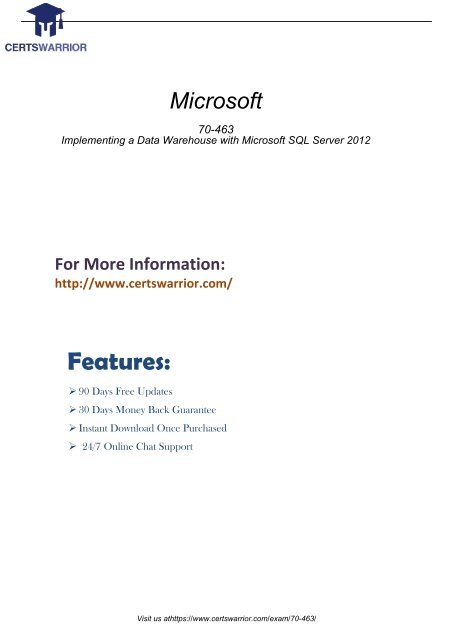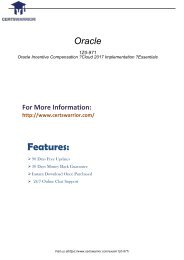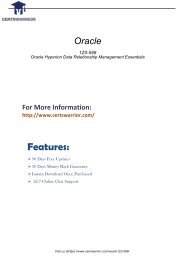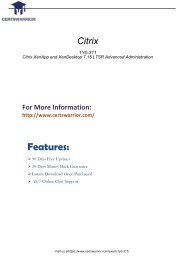70-463 Practice Software
We offer you free sample questions along answers prepared by the professionals of the IT field. You can easily pass your 70-463 Test with our Training Kits. For more info please visit here: http://www.certsgrade.com/pdf/70-463/
We offer you free sample questions along answers prepared by the professionals of the IT field. You can easily pass your 70-463 Test with our Training Kits. For more info please visit here: http://www.certsgrade.com/pdf/70-463/
Create successful ePaper yourself
Turn your PDF publications into a flip-book with our unique Google optimized e-Paper software.
Microsoft<br />
<strong>70</strong>-<strong>463</strong><br />
Implementing a Data Warehouse with Microsoft SQL Server 2012<br />
For More Information:<br />
http://www.certswarrior.com/<br />
Features:<br />
‣ 90 Days Free Updates<br />
‣ 30 Days Money Back Guarantee<br />
‣ Instant Download Once Purchased<br />
‣ 24/7 Online Chat Support<br />
Visit us athttps://www.certswarrior.com/exam/<strong>70</strong>-<strong>463</strong>/
Question: 1<br />
You are developing a project that contains multiple SQL Server Integration Services (SSIS) packages. The<br />
packages will be deployed to the SSIS catalog. One of the steps in each package accesses an FTP site to<br />
download sales transaction data.<br />
You create project parameters to store the username and password that are used to access the FTP site.<br />
You need to ensure that the username and password values are encrypted when they are deployed.<br />
What should you do?<br />
A. Set the Sensitive property of the parameters to True.<br />
B. Set the ProtectionLevel property of the package to EncryptSensitiveWithUserKey.<br />
C. Change the parameters to package parameters.<br />
D. Change the project to the Legacy Deployment model.<br />
Question: 2<br />
Answer: A<br />
You develop a SQL Server Integration Services (SSIS) package that imports SQL Azure data into a data<br />
warehouse every night.<br />
The SQL Azure data contains many misspellings and variations of abbreviations. To import the data, a<br />
developer used the Fuzzy Lookup transformation to choose the closest-matching string from a reference<br />
table of allowed values. The number of rows in the reference table is very large.<br />
If no acceptable match is found, the Fuzzy Lookup transformation passes a null value.<br />
The current setting for the Fuzzy Lookup similarity threshold is 0.50.<br />
Many values are incorrectly matched.<br />
You need to ensure that more accurate matches are made by the Fuzzy Lookup transformation without<br />
degrading performance.<br />
What should you do?<br />
A. Change the Exhaustive property to True.<br />
B. Change the similarity threshold to 0.55.<br />
C. Change the similarity threshold to 0.40.<br />
D. Increase the maximum number of matches per lookup.<br />
Explanation:<br />
http://msdn.microsoft.com/en-us/library/ms137786.aspx<br />
Question: 3<br />
Answer: B<br />
Visit us athttps://www.certswarrior.com/exam/<strong>70</strong>-<strong>463</strong>/
You install a SQL Server 2012 database engine instance on a production server. A month later, you install<br />
SQL Server 2012 Integration Services (SSIS).<br />
You must develop an SSIS project and deploy it to the server by using the Project Deployment model.<br />
Operations Log records that are outside the configured retention period must be cleaned automatically.<br />
You need to create the SSIS catalog on the production server.<br />
What should you do? (Each correct answer presents part of the solution. Choose all that apply.)<br />
A. Enable XP Command Shell.<br />
B. Enable CLR Integration.<br />
C. Enable OLE Automation.<br />
D. Start the SQL Server Browser service.<br />
E. Enable Cross Database Ownership Chaining<br />
F. Start the SQL Server Agent service<br />
G. Enable Ad Hoc Remote Queries.<br />
Explanation:<br />
Ref: http://msdn.microsoft.com/en-us/library/gg471509(v=sql.110).aspx<br />
Question: 4<br />
Answer: B, F<br />
DRAG DROP<br />
A SQL Server Integration Services (SSIS) package named DataFeed interacts with an external vendor data<br />
feed. The package is executed several times a day, either as part of other packages' control flow or by<br />
itself. The external data feed is unreliable because network failures and slow response times are<br />
frequent. The package is currently deployed on the file system.<br />
To analyze the reliability of the external data feed, you must collect execution data.<br />
Every time the DataFeed package is executed, the following information must be logged:<br />
Start Time<br />
End Time<br />
Execution Result<br />
Execution Duration<br />
You need to design a logging solution that meets the requirements by using the least amount of<br />
administrative and development effort.<br />
Which three actions should you perform in sequence? (To answer, move the appropriate actions from<br />
the list of actions to the answer area and arrange them in the correct order.)<br />
Visit us athttps://www.certswarrior.com/exam/<strong>70</strong>-<strong>463</strong>/
Answer:<br />
Explanation:<br />
Ref: http://msdn.microsoft.com/en-us/library/hh479592.aspx<br />
Question: 5<br />
A SQL Server Integration Services (SSIS) package on a computer is failing periodically in production. The<br />
package was created less than one year ago and was deployed to the SSIS catalog.<br />
Sometimes the package is started on a SQL Agent schedule; sometimes the package is started manually<br />
by an SSIS developer by using the Object Explorer in SQL Server Management Studio.<br />
You need to identify the authenticated user responsible for starting the package each time it failed in<br />
the past.<br />
Where can you find this information?<br />
A. the SQL Server Log<br />
B. the SSISDB.[catalog].[executions] view<br />
C. the SSISDB.[catalog].[event_messages] view<br />
D. the SQL Agent Job History<br />
E. the SQL Agent Error Log<br />
Question: 6<br />
Answer: B<br />
You maintain a SQL Server Integration Services (SSIS) package. The package was developed by using SQL<br />
Server 2008 Business Intelligence Development Studio (BIDS).<br />
The package includes custom scripts that must be upgraded.<br />
Visit us athttps://www.certswarrior.com/exam/<strong>70</strong>-<strong>463</strong>/
You need to upgrade the package to SQL Server 2012.<br />
Which tool should you use?<br />
A. SSIS Upgrade Wizard in SQL Server 2008 BIDS<br />
B. SSIS Upgrade Wizard in SQL Server Data Tools<br />
C. SQL Server DTExecUI utility (dtexecui.exe)<br />
D. SQL Server dtexec utility (dtexec.exe)<br />
Answer: B<br />
Question: 7<br />
DRAG DROP<br />
You are editing a SQL Server Integration Services (SSIS) package that contains a task with a sensitive<br />
property.<br />
You need to create a project parameter and configure it so that its value is encrypted when it is<br />
deployed to the SSIS catalog.<br />
Which three steps should you perform in sequence? (To answer, move the appropriate actions from the<br />
list of actions to the answer area and arrange them in the correct order.)<br />
Answer:<br />
DRAG DROP<br />
Question: 8<br />
Visit us athttps://www.certswarrior.com/exam/<strong>70</strong>-<strong>463</strong>/
A new SQL Server Integration Services (SSIS) project is deployed to the SSIS catalog.<br />
To troubleshoot some data issues, you must output the data streaming through several data flows into<br />
text files for further analysis. You have the list of data flow package paths and identification strings of<br />
the various task components that must be analyzed.<br />
You need to create these output files with the least amount of administrative and development effort.<br />
Which three stored procedures should you execute in sequence? (To answer, move the appropriate<br />
actions from the list of actions to the answer area and arrange them in the correct order.)<br />
Answer:<br />
Explanation:<br />
Ref: http://msdn.microsoft.com/en-gb/library/hh230989(v=sql.110).aspx<br />
Question: 9<br />
You are reviewing the design of an existing fact table named factSales, which is loaded from a SQL Azure<br />
database by a SQL Server Integration Services (SSIS) package each day. The fact table has approximately<br />
1 billion rows and is dimensioned by product, sales date, and sales time of day.<br />
The database administrator is concerned about the growth of the database. Users report poor reporting<br />
performance against this database. Reporting requirements have recently changed and the only<br />
Visit us athttps://www.certswarrior.com/exam/<strong>70</strong>-<strong>463</strong>/
emaining report that uses this fact table reports sales by product name, sale month, and sale year. No<br />
other reports will be created against this table.<br />
You need to reduce the report processing time and minimize the growth of the database.<br />
What should you do?<br />
A. Partition the table by product type.<br />
B. Create a view over the fact table to aggregate sales by month.<br />
C. Change the granularity of the fact table to month.<br />
D. Create an indexed view over the fact table to aggregate sales by month.<br />
Question: 10<br />
Answer: C<br />
You are designing a data warehouse with two fact tables. The first table contains sales per month and<br />
the second table contains orders per day.<br />
Referential integrity must be enforced declaratively.<br />
You need to design a solution that can join a single time dimension to both fact tables.<br />
What should you do?<br />
A. Create a time mapping table.<br />
B. Change the level of granularity in both fact tables to be the same.<br />
C. Merge the fact tables.<br />
D. Create a view on the sales table.<br />
Question: 11<br />
Answer: B<br />
You are designing a data warehouse for a software distribution business that stores sales by software<br />
title. It stores sales targets by software category. <strong>Software</strong> titles are classified into subcategories and<br />
categories. Each software title is included in only a single software subcategory, and each subcategory is<br />
included in only a single category. The data warehouse will be a data source for an Analysis Services<br />
cube.<br />
The data warehouse contains two fact tables:<br />
factSales, used to record daily sales by software title<br />
factTarget, used to record the monthly sales targets by software category<br />
Reports must be developed against the warehouse that reports sales by software title, category and<br />
subcategory, and sales targets.<br />
You need to design the software title dimension. The solution should use as few tables as possible while<br />
supporting all the requirements.<br />
What should you do?<br />
Visit us athttps://www.certswarrior.com/exam/<strong>70</strong>-<strong>463</strong>/
A. Create three software tables, dim<strong>Software</strong>, dim<strong>Software</strong>Category, and dim<strong>Software</strong>Subcategory and<br />
a fourth bridge table that joins software titles to their appropriate category and subcategory table<br />
records with foreign key constraints. Direct the cube developer to use key granularity attributes.<br />
B. Create three software tables, dim<strong>Software</strong>, dim<strong>Software</strong>Category, and dim<strong>Software</strong>Subcategory.<br />
Connect factSales to all three tables and connect factTarget to dim<strong>Software</strong>Category with foreign key<br />
constraints. Direct the cube developer to use key granularity attributes.<br />
C. Create one table, dim<strong>Software</strong>, which contains <strong>Software</strong> Detail, Category, and Subcategory columns.<br />
Connect factSales to dim<strong>Software</strong> with a foreign key constraint. Direct the cube developer to use a nonkey<br />
granularity attribute for factTarget.<br />
D. Create two tables, dim<strong>Software</strong> and dim<strong>Software</strong>Category. Connect factSales to dim<strong>Software</strong> and<br />
factTarget to dim<strong>Software</strong>Category with foreign key constraints. Direct the cube developer to use key<br />
granularity attributes.<br />
Question: 12<br />
Answer: C<br />
You are designing a data warehouse hosted on SQL Azure. The data warehouse currently includes the<br />
dimUser and dimDistrict dimension tables and the factSales fact table. The dimUser table contains<br />
records for each user permitted to run reports against the warehouse; and the dimDistrict table contains<br />
information about sales districts.<br />
The system is accessed by users from certain districts, as well as by area supervisors and users from the<br />
corporate headquarters.<br />
You need to design a table structure to ensure that certain users can see sales data for only certain<br />
districts. Some users must be permitted to see sales data from multiple districts.<br />
What should you do?<br />
A. Add a district column to the dimUser table.<br />
B. Partition the factSales table on the district column.<br />
C. Create a userDistrict table that contains primary key columns from the dimUser and dimDistrict<br />
tables.<br />
D. For each district, create a view of the factSales table that includes a WHERE clause for the district.<br />
Question: 13<br />
Answer: C<br />
You are reviewing the design of a customer dimension table in an existing data warehouse hosted on<br />
SQL Azure.<br />
The current dimension design does not allow the retention of historical changes to customer attributes<br />
such as Postcode.<br />
You need to redesign the dimension to enable the full historical reporting of changes to multiple<br />
customer attributes including Postcode.<br />
What should you do?<br />
Visit us athttps://www.certswarrior.com/exam/<strong>70</strong>-<strong>463</strong>/
A. Add StartDate and EndDate columns to the customer dimension.<br />
B. Add an IsCurrent column to the customer dimension.<br />
C. Enable Snapshot Isolation on the data warehouse.<br />
D. Add CurrentValue and PreviousValue columns to the customer dimension.<br />
Question: 14<br />
Answer: A<br />
You are implementing the indexing strategy for a fact table in a data warehouse. The fact table is named<br />
Quotes. The table has no indexes and consists of seven columns:<br />
• [ID]<br />
• [QuoteDate]<br />
• [Open]<br />
• [Close]<br />
• [High]<br />
• [Low]<br />
• [Volume]<br />
Each of the following queries must be able to use a columnstore index:<br />
• SELECT AVG ([Close]) AS [AverageClose] FROM Quotes WHERE [QuoteDate] BETWEEN<br />
'20100101' AND '20101231'.<br />
• SELECT AVG([High] - [Low]) AS [AverageRange] FROM Quotes WHERE [QuoteDate] BETWEEN<br />
'20100101' AND '20101231'.<br />
• SELECT SUM([Volume]) AS [SumVolume] FROM Quotes WHERE [QuoteDate] BETWEEN<br />
'20100101' AND '20101231'.<br />
You need to ensure that the indexing strategy meets the requirements. The strategy must also minimize<br />
the number and size of the indexes.<br />
What should you do?<br />
A. Create one columnstore index that contains [ID], [Close], [High], [Low], [Volume], and [QuoteDate].<br />
B. Create three coiumnstore indexes:<br />
One containing [QuoteDate] and [Close]<br />
One containing [QuoteDate], [High], and [Low]<br />
One containing [QuoteDate] and [Volume]<br />
C. Create one columnstore index that contains [QuoteDate], [Close], [High], [Low], and [Volume].<br />
D. Create two columnstore indexes:<br />
One containing [ID], [QuoteDate], [Volume], and [Close]<br />
One containing [ID], [QuoteDate], [High], and [Low]<br />
Explanation:<br />
Reference: http://msdn.microsoft.com/en-us/library/gg492088.aspx<br />
Reference: http://msdn.microsoft.com/en-us/library/gg492153.aspx<br />
Answer: C<br />
Visit us athttps://www.certswarrior.com/exam/<strong>70</strong>-<strong>463</strong>/
Question: 15<br />
You are designing an enterprise star schema that will consolidate data from three independent data<br />
marts. One of the data marts is hosted on SQL Azure.<br />
Most of the dimensions have the same structure and content. However, the geography dimension is<br />
slightly different in each data mart.<br />
You need to design a consolidated dimensional structure that will be easy to maintain while ensuring<br />
that all dimensional data from the three original solutions is represented.<br />
What should you do?<br />
A. Create a junk dimension for the geography dimension.<br />
B. Implement change data capture.<br />
C. Create a conformed dimension for the geography dimension.<br />
D. Create three geography dimensions.<br />
Question: 16<br />
Answer: C<br />
To facilitate the troubleshooting of SQL Server Integration Services (SSIS) packages, a logging<br />
methodology is put in place.<br />
The methodology has the following requirements:<br />
• The deployment process must be simplified.<br />
• All the logs must be centralized in SQL Server.<br />
• Log data must be available via reports or T-SQL.<br />
• Log archival must be automated.<br />
You need to configure a logging methodology that meets the requirements while minimizing the amount<br />
of deployment and development effort.<br />
What should you do?<br />
A. Open a command prompt and run the gacutil command.<br />
B. Open a command prompt and execute the package by using the SQL Log provider and running the<br />
dtexecui.exe utility.<br />
C. Add an OnError event handler to the SSIS project.<br />
D. Use an msi file to deploy the package on the server.<br />
E. Configure the output of a component in the package data flow to use a data tap.<br />
F. Run the dtutil command to deploy the package to the SSIS catalog and store the configuration in SQL<br />
Server.<br />
G. Open a command prompt and run the dtexec /rep /conn command.<br />
H. Open a command prompt and run the dtutil /copy command.<br />
I. Open a command prompt and run the dtexec /dumperror /conn command.<br />
J. Configure the SSIS solution to use the Project Deployment Model.<br />
K. Create a reusable custom logging component and use it in the SSIS project.<br />
Visit us athttps://www.certswarrior.com/exam/<strong>70</strong>-<strong>463</strong>/
Answer: B<br />
Explanation:<br />
Reference:<br />
http://msdn.microsoft.com/en-us/library/ms140246.aspx<br />
http://msdn.microsoft.com/en-us/library/ms180378(v=sql.110).aspx<br />
Question: 17<br />
You are developing a SQL Server Integration Services (SSIS) project that copies a large amount of rows<br />
from a SQL Azure database. The project uses the Package Deployment Model. This project is deployed to<br />
SQL Server on a test server.<br />
You need to ensure that the project is deployed to the SSIS catalog on the production server.<br />
What should you do?<br />
A. Open a command prompt and run the dtexec /dumperror /conn command.<br />
B. Create a reusable custom logging component and use it in the SSIS project.<br />
C. Open a command prompt and run the gacutil command.<br />
D. Add an OnError event handler to the SSIS project.<br />
E. Open a command prompt and execute the package by using the SQL Log provider and running the<br />
dtexecui.exe utility.<br />
F. Open a command prompt and run the dtexec /rep /conn command.<br />
G. Open a command prompt and run the dtutil /copy command.<br />
H. Use an msi file to deploy the package on the server.<br />
I. Configure the SSIS solution to use the Project Deployment Model.<br />
J. Configure the output of a component in the package data flow to use a data tap.<br />
K. Run the dtutil command to deploy the package to the SSIS catalog and store the configuration in SQL<br />
Server.<br />
References:<br />
http://msdn.microsoft.com/en-us/library/hh231102.aspx<br />
http://msdn.microsoft.com/en-us/library/hh213290.aspx<br />
http://msdn.microsoft.com/en-us/library/hh213373.aspx<br />
Question: 18<br />
Answer: I<br />
You are developing a SQL Server Integration Services (SSIS) package.<br />
To process complex scientific data originating from a SQL Azure database, a custom task component is<br />
added to the project.<br />
You need to ensure that the custom component is deployed on a test environment correctly.<br />
What should you do?<br />
Visit us athttps://www.certswarrior.com/exam/<strong>70</strong>-<strong>463</strong>/
A. Add an OnError event handler to the SSIS project.<br />
B. Open a command prompt and run the gacutil command.<br />
C. Configure the SSIS solution to use the Project Deployment Model.<br />
D. Open a command prompt and run the dtexec /dumperror /conn command.<br />
E. Configure the output of a component in the package data flow to use a data tap.<br />
F. Open a command prompt and execute the package by using the SQL Log provider and running the<br />
dtexecui.exe utility.<br />
G. Open a command prompt and run the dtexec /rep /conn command.<br />
H. Run the dtutil command to deploy the package to the SSIS catalog and store the configuration in SQL<br />
Server.<br />
I. Use an msi file to deploy the package on the server.<br />
J. Open a command prompt and run the dtutil /copy command.<br />
K. Create a reusable custom logging component and use it in the SSIS project.<br />
Reference:<br />
http://msdn.microsoft.com/en-us/library/ms403356.aspx<br />
Question: 19<br />
Answer: B<br />
DRAG DROP<br />
A SQL Server Integration Services (SSIS) project has been deployed to the SSIS catalog. The project<br />
includes a project Connection Manager to connect to the data warehouse.<br />
The SSIS catalog includes two Environments:<br />
Development<br />
QA<br />
Each Environment defines a single Environment Variable named ConnectionString of type string. The<br />
value of each variable consists of the connection string to the development or QA data warehouses.<br />
You need to be able to execute deployed packages by using either of the defined Environments.<br />
Which three actions should you perform in sequence? (To answer, move the appropriate actions from<br />
the list of actions to the answer area and arrange them in the correct order.)<br />
Visit us athttps://www.certswarrior.com/exam/<strong>70</strong>-<strong>463</strong>/
Answer:<br />
Question: 20<br />
You develop and deploy a SQL Server Integration Services (SSIS) package.<br />
The package is stored in the file system.<br />
You need to execute the package without importing it to the SSIS server.<br />
What should you use to execute the package? (Each correct answer presents a complete solution.<br />
Choose all that apply.)<br />
A. catalog.start_package<br />
B. dtexec<br />
C. SQL Server Management Studio<br />
D. SQL Server Agent<br />
Explanation:<br />
Ref: http://technet.microsoft.com/en-us/library/ms141<strong>70</strong>8(v=sql.110).aspx<br />
Answer: B, D<br />
Visit us athttps://www.certswarrior.com/exam/<strong>70</strong>-<strong>463</strong>/
Powered by TCPDF (www.tcpdf.org)<br />
http://www.certswarrior.com/ Questions and Answers (PDF)<br />
For More Information – Visit link below:<br />
http://www.certswarrior.com<br />
20% Discount Coupon Code:<br />
20off2016<br />
Visit us athttps://www.certswarrior.com/exam/<strong>70</strong>-<strong>463</strong>/<br />
http://www.certswarrior.com/exam/M2180-651/<br />
Page | 1
















